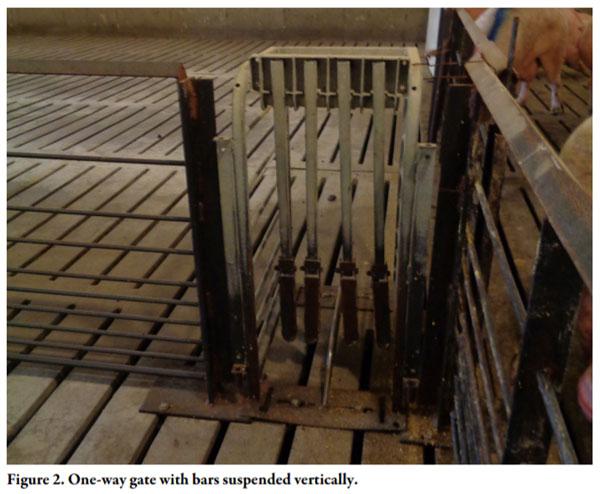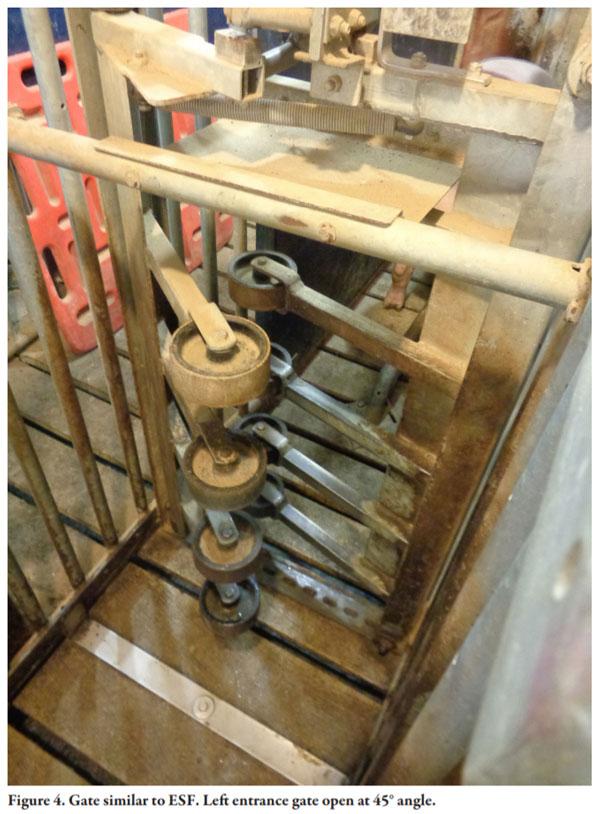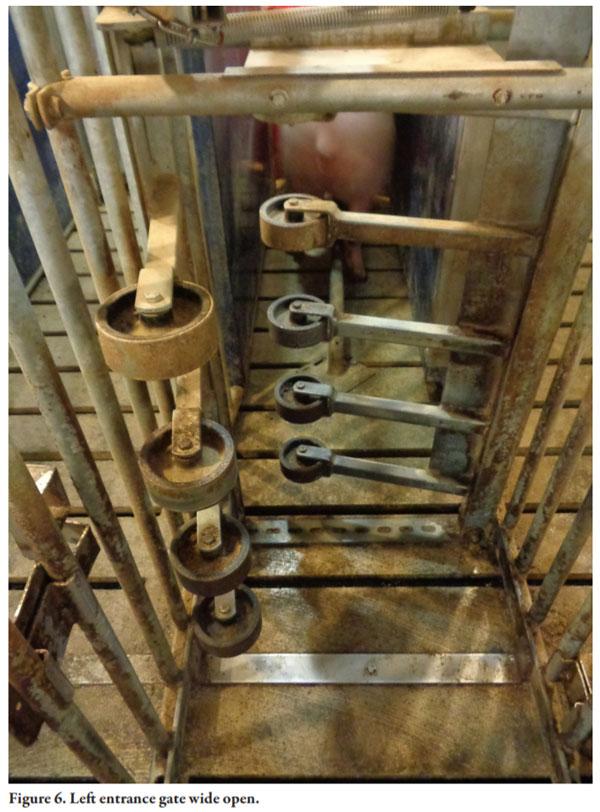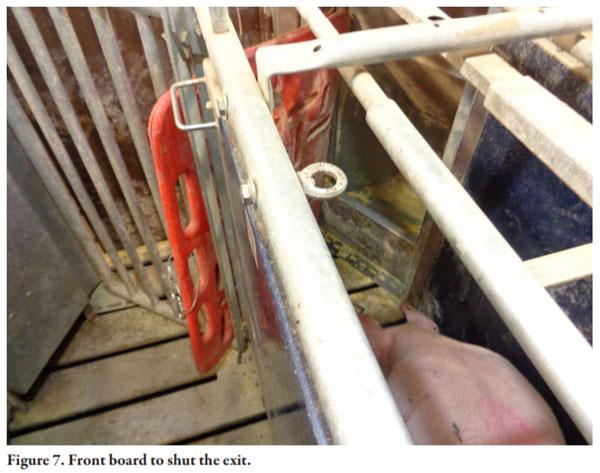Introduction
The U.S. swine industry is facing a significant change in production practices regarding gestation sow housing. Many pork producers across the United States are shifting from housing gestating sows in individual stalls to a group housing system. This is driven by animal welfare concerns, state legislatures, and food companies’ demands.
Electronic sow feeding (ESF) is one option for feeding gestating sows within a group housing system. Electronic sow feeding systems are a means to manage and monitor individual feed intake and provide opportunities to adjust feeding program strategies to better satisfy gestation nutrient requirements. However, in order to get the maximum benefits from the ESF systems, training of replacement gilts is a priority.
Gilts need to be comfortable with the entrance and exit gates of ESF feeding stations. If they are not comfortable and do not eat they may lose body condition and have poor reproductive performance. This may result in an increased gilt culling rate. Therefore, the following information will demonstrate key concepts of a gilt ESF training protocol.
Procedures
The implementation of ESF systems requires a significant change in how the gilts are managed. Besides the reproductive management, the employees will have to control the feed system and train gilts to use the feeding stations before mating. Designated gilt training personnel must have a unique personality. The trainers must be able to observe how gilts behave and establish a connection with the animals. The trainers must be patient enough to let the gilts explore the environment and become curious about the station gates instead of pushing them forcibly through the system. Training needs to be a positive experience for the gilts. Many producers often underestimate the time it takes to properly train gilts.
The training is divided into three different stages, which include: pre-training, training, and post-training (Figure 1).
Pre-Training Stage
Replacement gilts can be acclimated to ESF stations during the growing phase by using training gates. The main goal of the pre-training stage is to expose gilts to gates and allow them to become familiar with walking through gates. Thus, gilts will be expected to have less fear when facing the entrance gates of the feeding stations.
The acclimation to the ESF units can be performed in different ways. After entering the farm at approximately 11 wk of age, gilts are allocated into grower pens containing training gates. These methods can range from low input one-way gating to higher input methods that closely mimic the equipment and flow of gilts through the ESF system.
Low Input
In this method, the grower pen is subdivided into areas that contain feeding areas to provide ad libitum access to feed. Between these subdivisions there are simple one-way gates (Figure 2). If gilts want to move between these areas, they have to pass through those gates.
The one-way gates utilized in this method may have bars suspended vertically to attach so as to allow free movement, to accustom gilts to cross a physical barrier (Figure 2). The major advantage of this method is that it requires a low input of equipment and labor. However, it is not necessary to flow between the different sub areas of the pen to get access to feed and water. Therefore, some gilts may never walk through the gates during the pre-training stage.
Higher Input
In this method, the grower pen is subdivided by portable pen gates into 3 different areas: pre-feeding, feeding, and post-feeding area (Figure 3). Gilts stay in the pre-feeding area with gated access to conventional feeders.
Gilts will need to walk through these gates to move from the pre-feeding area to the feeding area, in order to get access to feed. After eating, gilts have to pass through training gates again to move to the post-feeding area, without being able to return to the other areas. In the first day at the grower pen, all gilts are kept in the pre-feeding area. Some gilts will pass through the gates at their own will. At the beginning of the second day, the farm staff will be able to identify the gilts that have not flowed to the feeding area. Thus the farm staff have to manually assist gilts that have not eaten into the feeding area. The process of ensuring all gilts flow through the gates every day is called “single pass.” In our experience, this is performed for the first 7 d after gilts enter the area. Hereafter, the portable pen gate is removed and the pre- and post-feeding areas become a single common area.
For entry gates into the feeding area, similar gates as used in ESF stations are utilized. One type of gate requires gilts to physically open them (Figure 4). Initially, the left entrance gate remains opened at a 45° angle for the first wk in order to facilitate and encourage gilts to walk through them. As the gilts become accustomed to these gates, they can be completely closed.
Another type of gate used is set up with an electronic sensor that causes the gate to open automatically when a gilt gets close to it (Figure 5). Thereby, this gate facilitates and encourages gilts to move between those areas. These types of gates are easier to move than the ESF unit entry gates, since they do not require gilts to physically open them.
This method requires gilts to flow through a physical barrier to get feed access, making them learn by positive reinforcement. However, this method requires the farm staff to dedicate time to initially manually assist gilts into the feeding area, which increases labor demands. The major advantage is that with the single pass system, gilts can be easily monitored to determine the number of gilts acclimated to the system. Also, it is expected that a higher level of acclimatization to the ESF station will occur compared to the low input method since the single pass system mimics the flow through the ESF system.
The pre-training period in the grower pen helps to properly introduce gilts to the new feeding system. One-way gates are a good tool to help gilts grow accustomed to them.
Training Stage
The primary purpose of this stage is to train gilts to eat at the ESF stations. Depending on the level of acclimatization in the pre-training stage, gilts may have to be trained to enter the ESF feeding stations as well. During this stage the gilts have undergone the final gilts selection process and an radio frequency identification (RFID) ear tag has been placed. A large number of gilts can be trained at the same time but adequate staffing must be provided during the training period. Also, in our experience, it is recommended a period of 2 wk to be allocated for the gilt training process. A significant amount of the time commitment occurs in the first wk with additional time needed in the second week monitoring to ensure gilts are regularly using the feeding stations.
The gilt training pen design varies between swine production systems. The gilt training pen illustrated in this paper has a capacity to house 250 gilts, providing 19 sq ft/gilt.
The pen is equipped with 24 nipple waterers to provide ad libitum access to water and 6 standard ESF stations set up as learning stations. Each feeding station is designed for approximately 42 gilts. It is suggested dispensing approximately 50% water with every feed drop, increasing the rate of eating. The staff has to ensure that the water being provided in the equipment is working correctly.
A single pass system such as described for the pre-training phase that does not allow gilt movement directly from the exit of the feeding station back to the entrance area is critical. There should be a post feeding area for gilts to rest after eating, with gating to subdivide the pen into pre- and post-feeding areas. Twenty-four hours prior to training, gilts are moved to the gilt training pen. Once the group is there, the portable pen gate is shut to start a single pass through the feeding station. Depending on pen configuration, additional penning may be provided, limiting the gilts near the entrance of the feeding area in order to further encourage them to begin passing through the ESF system.
Some of the untrained gilts will enter the stations at their own will. With the single pass system, the next day, the trainer will easily know which gilts have not eaten. Our experience in a commercial sow herd using this system, along with the higher input pre-training system, indicates that the first day after placement in the pen, approximately 60% of the gilts need to be manually delivered to the feeding station. This percentage decreases with time and by the fifth day only 30% of gilts require manual assistance through the gates, and few require assistance after the eighth day.
Days 1 to 4: In addition to the pen gates that keep gilts near the entry portion of the feeding stations, the ESF left entrance gate is tied open for the first 4 days (Figure 6). The aim of it is to arouse the gilts curiosity regarding the stations, and consequently motivate them to walk through the ESF gates.
Also, during this time, the trainer has to calmly start guiding the gilts from the prefeeding area into the feeding stations. A sorting board can be used to encourage them to the entrance gate if necessary. However, it is critical this is done in a calm and positive manner so that the gilt does not develop negative associations with the feeding station.
Once a gilt enters the feeding station, there should be a mechanism in place to close the exit of the station during the training. The purpose of it is to prevent gilts from running directly from the entry to the exit of the ESF unit without being trained. One example of a simple mechanism is to shut the exit of the feeding station with a sorting board (Figure 7).
Once the gilts are inside the ESF station, the entrance gate is locked. The trainer has to manually drop feed in the bowl to attract the gilts to the feed. In the ESF system exemplified in this paper, the maximum time between the gilts entering the station, and getting close to the bowl where their RFID ear tag is identified, is approximately 30 sec. If the RFID has not been read by the ESF station within 30 sec, the entrance gate opens. Therefore, the trainer needs to close the gate manually, and use a board to narrow the space between the entrance and the feed bowl (Figure 8).
During the training time, each manually encouraged gilt is allowed to stay in the station for a period of 5 min. After that, the mechanism used to close the exit of the station has to be removed to allow the gilts to exit the station. In this example, the trainer takes off the front board enabling the gilt to exit the feeding station. The majority of gilts will have eaten at least a small amount of feed after 5 min. After this 5 min period, gilts that did not get even close to the bowl are allowed an extra 5 min to begin consuming their feed allotment. In this case, the trainer has to calmly direct these gilts to the feed bowl by using his hand to gently scratch their back, encouraging forward movement (Figure 9).
Some of the gilts will get somewhat stressed with the sound of the feed dropping. The trainer has to leave them in the station for an extra 5 to 10 min, depending on the gilt, in order to make them feel comfortable and lose the fear of that environment.
Even after 10 min, some gilts may not eat. This period serves for the animals to explore and familiarize themselves with the environment without stress, independently of eating or not. Therefore, the gilt is released after 10 min even if no feed was consumed. Feeding strategies may vary between farms. However, a typical setting is for a feed allowance for the first 4 d during the training process at 4.4 lb/d per gilt and with a feed delivery speed to drop 0.13 lb/min. Therefore, a gilt that starts eating as soon as she enters the station would eat approximately 0.65 lb during the 5 min training period.
During the first wk, it is advised that gilts should be eating at least 20% of the feed allowance, or between 0.9 and 1.3 lb/d. On d 3, the trainer should obtain from the software a report of feed delivery per gilt. The same procedures of d 1 and 2 are repeated, but now the goal is to ensure that all gilts eat. The gilts that haven’t gone through the ESF station on their own are gently persuaded towards the stations. The trainer makes sure a certain amount of feed is dispensed in the bowl to stimulate the gilts to eat.
However, during the first wk and specially the first day, gilts are not going to eat much feed. In our experience, the first day in the gilt training pen approximately 18% of the gilts haven’t eaten, 40% of them ate until 1.1 lb, 30 % ate until 2.2 lb, and only 12% of them ate between 2.2 and 4.4 lb of the allotted feed. At the end of the first week, approximately 50% of the gilts were eating more than 4.4 lb and less than 10% remained eating 1.1 lb or less.
In the beginning of the process, training gilts might take as long as 6 h considering that approximately 150 out of 250 gilts may need manual assistance to enter the feeding stations. The pen gate that divides the pen in pre and post feeding areas can be opened after the training. Thus gilts can freely circulate in the pen and even walk through the ESF stations again. During this period, gilts can enter the ESF station again and stay there enough time to eat as much as they want.
The feed system is programmed to start a new cycle every day at a specific time. The staff has to close the pen gate and move all the gilts to the pre feeding area before the feed system resets, to monitor and identify the non-eaters the next day. It is suggested that the feed system be set to start another cycle in the late afternoon. This will provide enough time for the gilt training personnel perform the training and the single pass in a timely manner, and allow gilts that have not eaten their full feed allowance to consume further amounts of feed on subsequent passes through the system. Also, around d 4 of training the trainer has to gradually close the feeding station gate. A spacer can be used to prop up the left entrance gate of the feeding station open at a 45° angle.
Additionally, if the majority of the gilts are waiting in front of the bowl for more feed and the trainer visually observes little left-over feed, the feeding strategy may be changed. One example is to set the feed strategy to 6.6 lb/d and the feed speed to 0.22 lb/min when the next feed cycle starts.
Days 5, 6, and 7: The same procedures are continued to ensure that all gilts learn to consume feed at the feeding stations. The time each gilt is allowed to stay in the station during training goes up from 5 to 10 min because fewer animals need to be trained to walk through the system. After training, the loafing area gate is opened again, and some gilts will pass through the station at their own will. One hour later, the trainer might look for the gilts that ate less than 20% of their feed allotment, and assist them through the system before another feed cycle begins. These gilts should be allowed to stay in the station for enough time to eat as much as they want.
Days 8 and later: Based on the daily feed report, the trainer should look for gilts have not learned how to use the ESF station and may need to consider culling these animals. Criteria we have seen used include gilts either not eating for more than 3 consecutive days at the end of the first wk of training or low total feed intake for the first wk of training. The trainer has to pay attention to the fact that sometimes when gilts are in heat, they might not eat for two days. Thus, it is critical that the trainer be able to identify gilts that are displaying normal estrus signs and those that have not been trained to eat.
In the second week of training gilts that did not eat at least 40% of their daily feed allowance are targeted for manual assistance through the ESF station again, and gilt eating behavior is closely monitored to ensure they are operating the feeding system correctly. Also, these gilts are closely examined for injuries or other reason why their feed intake may be compromised. Again, feeding behavior is closely monitored and feed allotments increased. If most gilts are eating the allotted amount of feed, the feed strategy is changed to 8.8 lb/d, with the feed delivery speed increased. It is critical though that feed allotment is not increased too fast or there will be wasted feed and feed build-up in the feeding station.
Days 9 and 10: The trainer continues assisting gilts with a feed consumption lower than 40% through the system. Starting on d 10, the entrance gate of the feeding station is left completely closed. The individual training comes to an end, and the gilts have to pass through the system at their will. However, the trainer has to look at the daily feed report to detect early signs of gilts that are not eating. Typically, after 2 weeks of training, gilts are moved to an ESF pen or breeding stall for observation of signs of estrus.
Post-Training Stage
Again as during the training stage on the first day in this new environment, the staff should ensure that non-eaters are flowing through the feeding stations. After four days, if there are any gilts that have a feed consumption less than a target of, for example, 40% of the feed allowance or 3.5 lb/day, they may be candidates for further subsequent training or culling.
Conclusion
Gilt training to utilize the ESF system is a challenge for many pork producers using ESF. Often the time commitment required for training gilts in ESF systems is underestimated. Additionally, it is important to acclimate gilts to the feeding system during the growing phase. Individual producers may need to make adjustments according to their situation and facilities. However, it is critical that the training occurs in three stages, which include pre-training, training, and post-training. The use of gates in the pre-training stage, the single pass practice, and the individual feed intake tracking are important events that have to be performed. Gilt training programs are critical to successfully implement an ESF system. Training programs require a lot of patience and properly trained employees for success.









This article was originally published in Kansas Agricultural Experiment Station Research Reports: Vol. 2: Iss. 8. https://doi.org/10.4148/2378-5977.1283. This is an Open Access article licensed under a Creative Commons Attribution 4.0 License. 



























